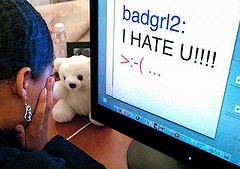Cyberbullying linked to psychiatric and social issues

Traditional bullying involves face-to-face taunts – where the victim knows who the bully is. It has escalated to cyberbullying sometimes by an anonymous source. Cyberbullies hide behind their computers and cell phones to wreak havoc on their victims.
A survey was conducted recently in Finland. Over 2200 teens between the ages of 13 and 16 were questioned about their experiences with cyberbullying. The report was published in the July, 2010 issue of Archives of General Psychiatry.
 It stated that 7.4% of the students said that they had bullied someone by electronic means – over the Internet or by cell phone. 4.8% said they had been the victim of cyberbullying, while 5.4% reported being both a victim and a perpretator. The author of the report, Andre Sourander, stated that “Traditional bullying typically occurs on schoolgrounds, so victims are safe at least within their homes. With cyberbullying, victims are accessible 24 hours a day, seven days a week. There is no time when messages cannot be left on mobile telephones or sent via e-mail.”
It stated that 7.4% of the students said that they had bullied someone by electronic means – over the Internet or by cell phone. 4.8% said they had been the victim of cyberbullying, while 5.4% reported being both a victim and a perpretator. The author of the report, Andre Sourander, stated that “Traditional bullying typically occurs on schoolgrounds, so victims are safe at least within their homes. With cyberbullying, victims are accessible 24 hours a day, seven days a week. There is no time when messages cannot be left on mobile telephones or sent via e-mail.”
The majority of victims perceived a definite amount of difficulty in their lives. They reported emotional and peer problems, not feeling safe in school, headaches, abdominal pain and sleep problems. The cyberbullies also experienced difficulties in their lives. They struggled to get along with other people, were hyperactive and had trouble concentrating. They also reported smoking and being drunk frequently.
Finland’s findings support many studies in recent years about the prevalence and destructiveness of cyberbullying. For more about cyberbullying and how to deal with it take a look at:
www.wiredsafety.org
www.netsmartz.org


